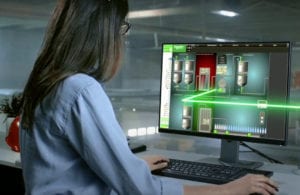 Industry 4.0 Powered by IEC 61499
Industry 4.0 Powered by IEC 61499
The future of industrial automation is wide open. What’s holding us back?
Imagine a future where industrial organizations thrive by adapting with agility to ever changing market conditions on both the supply and demand sides. In this world, new business models are enabled by an open, non-proprietary platform that offers holistic control based on real-time management of business goals. Operations and fundamental processes are integrated into a seamless business, automation, and control system that orchestrates supply chains, business systems, operations, production, logistics, and customer service. Innovative industrial automation technologies create step-change improvements in operations. The result is faster delivery, lower cost and ultimately, faster cycle times for delivering products to consumers.
What is stopping us from unleashing the true power of digitization and achieving this new level of innovation, unprecedented efficiency, and greater agility? The constraints are more historical and psychological than they are technical.
An explosion of very low-cost intelligent sensors and open computing platforms already simplify connectivity and system control and could enable the use of machine learning and artificial intelligence. In fact, intelligence can now be distributed among software resources in the cloud, at the edge and embedded within controllers and field devices.
Advancements in technologies and the development of open standards are also combining to allow manufacturers to modernize without having to incur high core-system replacement costs or to disrupt ongoing operations.
Yet, many manufacturers are unable to accrue such benefits due to an attachment and dependency on proprietary automation system legacies.
From legacy proprietary automation systems to a plug and produce open platform
Since most leading automation system suppliers today offer proprietary systems to end users, their customers are “locked in” to specific technologies. For many of these end users, migration to a different PLC/DCS supplier is highly challenging from a ROI perspective.
However, proprietary approaches limit access to innovation, increase total cost of ownership, and restrict the ability of manufacturing enterprises to adopt IT-world types of advancements. In the long run, plants inhibit their ability to evolve rapidly and to quickly establish marketplace advantages.
But it no longer has to be that way. According to Bill Lydon, Editor in Chief of Automation.com, next-generation manufacturing or production operation should be centered around a common open source architecture. This would follow the Internet and enterprise computing model driven by open standards. Industrial automation is really a use case of computing that has not matured enough to embrace these concepts. Look at the World Wide Web Consortium (W3C) website to get an idea of the scope of standards in the computing industry. Industrial automation systems should only be a multivendor interoperable open platform to implement new manufacturing and production models.
“Some manufacturing and production companies are trying to force evolutionary transformation by making incremental changes, keeping existing processes, and preserving existing assets,” says Lydon. “The focus is on leveraging new technology for refinements to generate cost savings and operational improvements. These incremental adjustments do not lead to profound process and business model changes.”
According to Lydon, transformative manufacturing and production processes, coupled with business model changes and enabled by technological shifts, will accelerate competitive position and result in significant ROI.
Lydon advocates taking whatever steps are necessary to enable a holistic control of automation, based on real-time business management goals with open multivendor architectures. “To achieve true ‘plug ‘n play,’ we need a single industry standard profile to add devices to automation systems regardless of native protocol. This is a reality in the computer industry today where adding devices such as printers, scanners, cameras, and external drives has become a ‘no brainer.’ Why can’t we do the same with automation systems?”
Standards are essential
In this new environment, Lydon notes that standards are extremely important for multivendor interoperability and seamless interfaces from supply chain through manufacturing and production to customer. The broadest programming standard for industrial automation and control today is IEC 61131-3. Due to the task structure of a full IEC 61131 implementation, event-driven, state and cyclical logic can be accomplished. There have been significant enhancements to IEC 61131 by the PLCopen organization including OPC UA for enterprise communications, remote procedure calls and controller to controller standardized data communication models. Another development is the international standard IEC 61499 that builds on IEC 61131 functions that defines a generic model for distributed control systems IEC 61499 features an event driven model built around functional blocks.
The big elephants in the room regardless of programming standard including IEC 61131 and IEC 61499 is the fact that traditional vendors have never fully embraced open implementations with code and function portability.
The Eclipse Foundation 4diac open source project fostering the further development of IEC 61499 may be a step in the right direction if embraced by traditional automation vendors.
Adoption of the IEC 61499 standard
Schneider believes the answer to Mr. Lydon’s question may lie in the adoption of the IEC 61499 standard, which was originally developed in the late ‘90s and early 2000’s. Because of the technology constraints at the time, the standard was not widely deployed. But now, given the evolution of technology, the IEC 61499 standard solves the problem of ensuring portability, configurability, and interoperability across vendors and, at the same time, software and hardware independence. Also, by accommodating and combining both scan-based and event-based mechanisms, the standard makes it easy for automation systems to adopt best practices coming from the IT world and to easily interface with enterprise systems. Moreover, the capability of reusing legacy systems through an IEC 61499-comaptible wrapper is being developed.
Organizations such as the Open Process Automation Forum (OPAF), and the User Association of Automation Technology in Process Industries (NAMUR) are end user groups advocating for changes to the existing proprietary automation systems paradigm. With the IEC 61499 standard and the interest of key automation vendors such as Schneider Electric to adopt open automation systems platforms, many of the ingredients are in place to help reshape the industrial automation systems horizon.




Conversation
Glad to see the enthusiasm. Happy to be one of the USA experts on the IEC61499 committee. Trying to find ways to be helpful in moving the technology along.
Thank you Bridget for your comment, we are very pleased by our collaboration with Wood and expect others to join for accelerating the adoption of the technology in order to realize the promise of Industry 4.0.
Thank you Matt for taking the time to comment on my blog. The IPC-CFX seems to be very complementary to IEC61499 for driving IT/OT convergence.